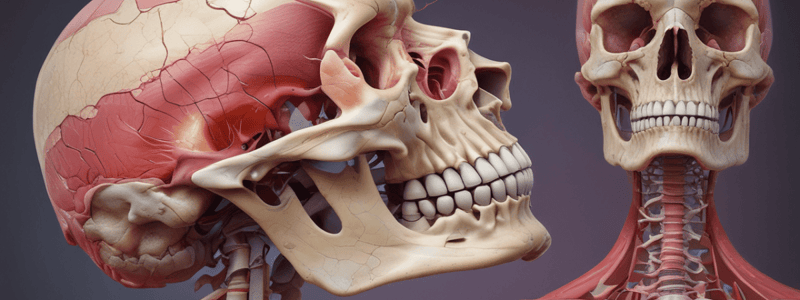Podcast
Questions and Answers
What is the most common site for giant cell tumors?
What is the most common site for giant cell tumors?
- Soft tissue surrounding the joint
- Proximal fibula
- Distal femur and proximal tibia (correct)
- metaphyseal of long bone
What percentage of giant cell tumors develop lung metastasis?
What percentage of giant cell tumors develop lung metastasis?
- 6%
- 4% (correct)
- 2%
- 8%
What is the typical age of onset for giant cell tumors?
What is the typical age of onset for giant cell tumors?
- Adolescence
- Third decade of life (correct)
- Childhood
- Elderly
What is the composition of a giant cell tumor?
What is the composition of a giant cell tumor?
What is the radiographic appearance of a giant cell tumor of the proximal fibula?
What is the radiographic appearance of a giant cell tumor of the proximal fibula?
What is the most common site for an Aneurysmal Bone Cyst (ABC)?
What is the most common site for an Aneurysmal Bone Cyst (ABC)?
Which cells are typically seen in the background of an Aneurysmal Bone Cyst?
Which cells are typically seen in the background of an Aneurysmal Bone Cyst?
What structures are the septa in an Aneurysmal Bone Cyst composed of?
What structures are the septa in an Aneurysmal Bone Cyst composed of?
What age group is most commonly affected by Aneurysmal Bone Cysts?
What age group is most commonly affected by Aneurysmal Bone Cysts?
What is a common symptom associated with Aneurysmal Bone Cysts?
What is a common symptom associated with Aneurysmal Bone Cysts?
What type of tumor is Ewing sarcoma?
What type of tumor is Ewing sarcoma?
What percentage of primary malignant bone tumors is Ewing sarcoma?
What percentage of primary malignant bone tumors is Ewing sarcoma?
Which of the following is NOT a characteristic of Ewing sarcoma?
Which of the following is NOT a characteristic of Ewing sarcoma?
What is the most common genetic abnormality found in Ewing sarcoma?
What is the most common genetic abnormality found in Ewing sarcoma?
What are the two genes involved in the characteristic balanced translocation of Ewing sarcoma?
What are the two genes involved in the characteristic balanced translocation of Ewing sarcoma?
What is the most common tissue of origin for Ewing sarcoma?
What is the most common tissue of origin for Ewing sarcoma?
What type of lesion is described in the text?
What type of lesion is described in the text?
What is the appearance of the lesion as described in the text?
What is the appearance of the lesion as described in the text?
Which of the following is NOT mentioned as a feature of the aneurysmal bone cyst in the text?
Which of the following is NOT mentioned as a feature of the aneurysmal bone cyst in the text?
What type of cells are indicated by the red arrows in the image description?
What type of cells are indicated by the red arrows in the image description?
What is the function of the structure indicated by the yellow arrow in the image description?
What is the function of the structure indicated by the yellow arrow in the image description?
What is the primary cause of uncontrolled growth and abnormal differentiation in long bones?
What is the primary cause of uncontrolled growth and abnormal differentiation in long bones?
Where do tumors typically arise in long bones?
Where do tumors typically arise in long bones?
What radiographic feature is described as an 'onion skin' appearance?
What radiographic feature is described as an 'onion skin' appearance?
What is the morphological feature of Ewing sarcoma cells observed under light microscopy?
What is the morphological feature of Ewing sarcoma cells observed under light microscopy?
What is the significance of Homer-Wright rosettes in Ewing sarcoma?
What is the significance of Homer-Wright rosettes in Ewing sarcoma?
How does the behavior of giant cell tumors compare to completely benign and malignant tumors?
How does the behavior of giant cell tumors compare to completely benign and malignant tumors?
Flashcards are hidden until you start studying




